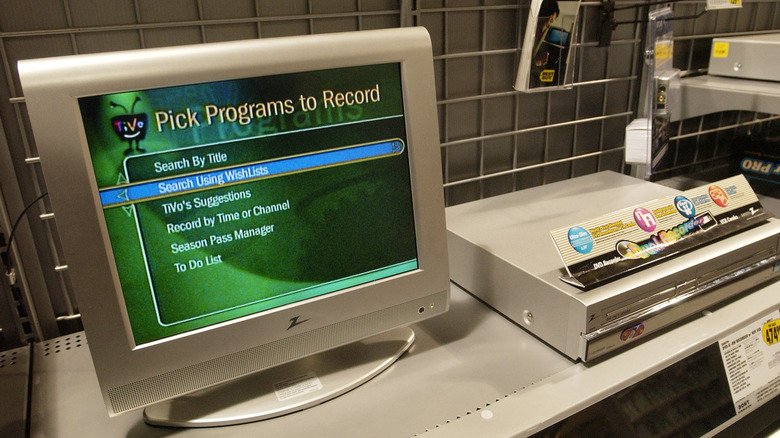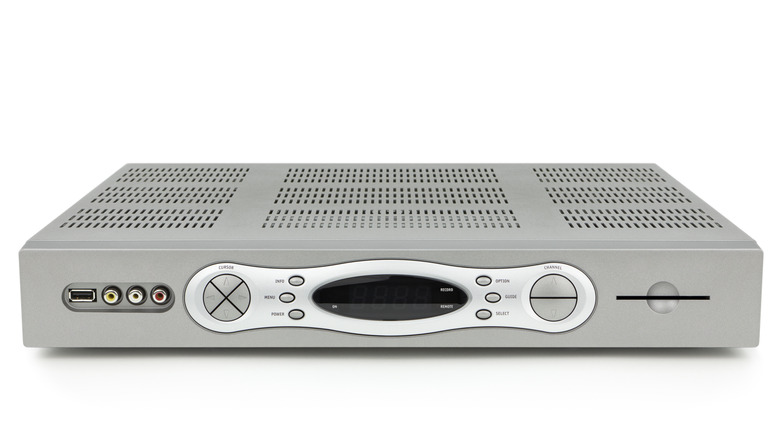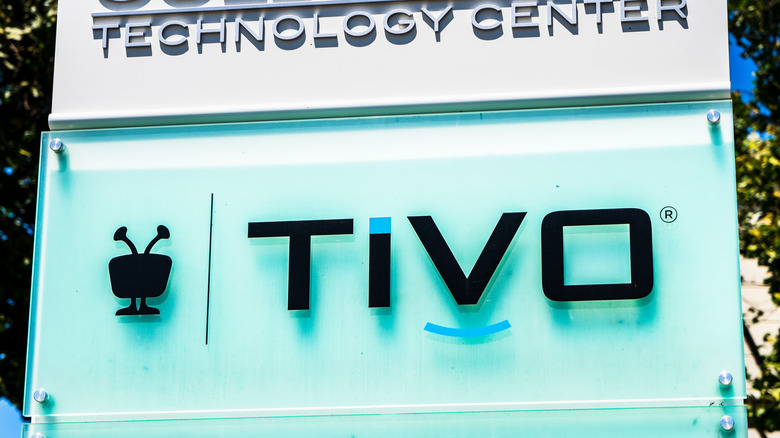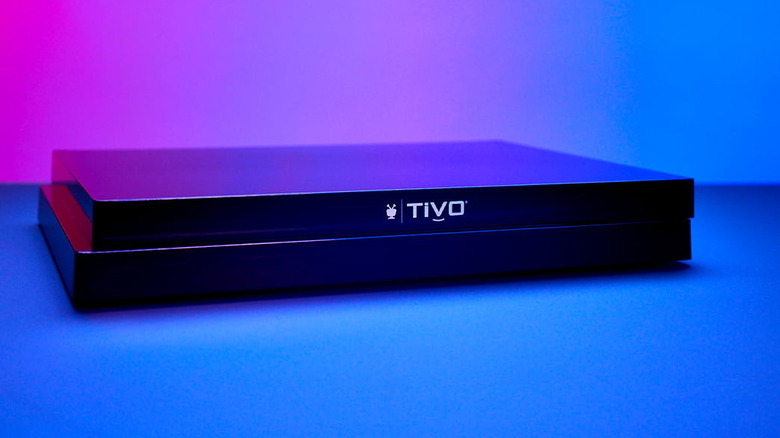Whatever Happened To TiVo?
Digital Video Recorders as we know them were born almost 25 years ago, with both TiVo and ReplayTV unveiling their initial DVRs at the January 1999 Consumer Electronics Show in Las Vegas. The technology was a game changer: Before, the time-shifting of TV programming was the domain of tape-based VCRs, which had many technological limitations. Now? You could pause and rewind live TV.
Setting a timer to record a show was widely considered so confusing that the nightmare of "programming a VCR" was routine joke fodder on sitcoms and in late-night talk show monologues. Recording from a cable box only complicated matters further, adding a second timer into the mix if the box even had one. And the lone attempt at simplifying this, VCR Plus+, wasn't that simple: It required entering a six-to-eight-digit code published in TV Guide or its competitors.
Where TiVo and ReplayTV changed the game was recording digitally to a hard drive and letting users pick shows from an interactive on-screen program guide. It was an appealing bit of innovation, with TiVo's superior user interface and recommendation features leaving ReplayTV in the dust.
As more time passed, though, TiVo was met with much stiffer competition in the form of DVRs rented out by cable companies, plus networks greatly expanded their video-on-demand offerings, making DVRs less necessary outside of sports programming or watching time-shifted shows on a delay shorter than the window for a VOD version to become available. In 2023, TiVo still exists, but it's long since fallen from name-brand status.
What made TIVo stand out
A November 16, 19998 article in This Week in Consumer Electronics was particularly good at crystalizing what made TiVo special enough to stand out above ReplayTV.
"The company, which said it has developed a high-resolution MPEG-2 hard disc-based recording system and intelligent program guide service, uses the slogan 'Giving you what you want, when you want it' to explain its mission," reads Greg Tarr's story. "The TiVo service, due to hit retail through a geographical rollout starting in the spring, uses online TV data services and software to memorize users' viewing habits and preferences and then will automatically select and record shows it determines a viewer will like."
The article quoted TiVo programming and network relations vice president Stacy Jolna as saying that "[w]e decided that using a giant onscreen spreadsheet of television program listings was not the most utilitarian or entertaining way of helping people find out what's on television." It started with a program guide, of course, but was augmented by thumbs up and thumbs down buttons on the remote that could be used to rate shows, with TiVo then using the resulting data to generate recommendations.
Though it took time for customers to understand what DVRs were capable of, some creative marketing helped get TiVo over the hump. In an oral history of the company published by OneZero in 2019, launch-time senior vice president of marketing and sales Brodie Keast said that sending free TiVos to popular talk show hosts like Howard Stern and Oprah Winfrey and getting them to plug TiVo to their fans, brought to light the appeal of the product.
Competition got ... complicated
In 2000, TiVo was thr clear leader in the DVR space, with the situation so dire for ReplayTV that it dumped its CEO and laid off half its staff en route to selling the company in early 2001. Not only was TiVo considered the superior product, but also the more business-savvy company between its requirement for a paid subscription and partnerships with the likes of DirecTV.
"At CES 2000, ReplayTV and TiVo were near each other on the floor," recalled then-TiVo chief evangelist Richard Bullwinkle in the 2019 oral history. "They had this gimmick where they had people shout, 'No monthly fees.' We wanted to shout, 'No business plan.'"
But two new kinds of competitors emerged in 2003 with mixed success: Increasingly affordable set-top DVD recorders from major electronics companies like Panasonic and cable company-provided DVRs. The cable company DVRs would become TiVo's primary competitor and eventually take over. They didn't require any additional hardware, just an increased cable box rental fee. Ultimately they provided a more seamless experience than separate boxes would.
Those cable company DVRs also played a significant role in killing the market for DVD recorders. Though some DVD recorders had hard drives with DVR-like features and the ability to use rewritable DVD formats like DVD-RW and DVD-RAM, their primary function was still recording to write-once DVD-Rs. Most people aren't archiving off-air TV recordings or digitizing lots of VHS tapes, so a DVD player for renting movies and a DVR for time-shifting TV was enough.
The decline of TiVo
It seems largely agreed upon that TiVo's biggest mistake was most likely focusing on being a hardware and subscription service company. Instead, it could have pivoted to being a company that primarily licensed its Kleenex-level genericized brand name and beloved interface to other companies, particularly cable and satellite companies.
"Boy, do I wish I had been beating on [TiVo co-founder Mike Ramsay's] door and saying, 'License it for a dollar and get it everywhere.'" admitted Richard Bullwinkle in the 2019 oral history. In a May 2023 edition of his TV Answer Man column, analyst Phillip Swann agreed. "[TiVo] placed too much emphasis on retail sales rather than focusing on licensing and partnerships." Swann also noted that five years in, despite the marketing blitz that made it the name brand DVR, TiVo had "just" 700,000 subscribers.
In 2016, TiVo was sold to Rovi, which Business Insider had dubbed "the most important company you've never heard of" in 2011 and abandoned that status by rebranding as The TiVo Corporation. There was a synergy there that made sense, as Rovi is the main provider of TV listing data as well as other similar content. (The former Rovi is also the owner of AllMusic.)
What is TiVo doing today?
The current TiVo still makes DVRs, with an offering as of this writing called the TiVo Edge line, with separate models for cable and over-the-air use. Reviews are mixed at best, though. PC Mag gave it 2.5 stars out of five, summing it up as "a perfectly serviceable DVR hampered by a high price, a dated interface, and the existence of streaming convenience," and TechHive gave it an identical score while bemoaning the addition to pre-roll ads appended to recordings. Sound and Vision was more positive, but still acknowledged some of the same flaws.
Reviews aside, using a TiVo for cable TV has also become less of a sure thing. Modern TiVos access cable channels via CableCARD, the technology that was supposed to replace cable boxes and allow devices like TiVo to tune cable channels themselves. It still exists, but in 2020, the FCC stopped requiring that long-resistant cable companies provide them.
In the grand scheme of things, this may not matter, though. Under the former Rovi, TiVo has shifted to a licensing-heavy model, to the point that, by 2019, 77% of its revenue was coming from "Platform Solutions," its division for providing DVR technology to cable companies. The company pivoted, but it was long after the founders were out of the picture.




